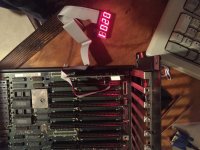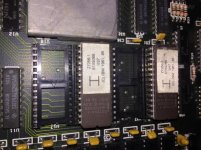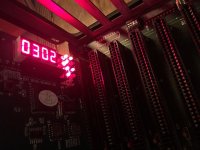offensive_Jerk
Veteran Member
I've got an earlier version IBM 5170 board with the piggy-back ram and 6mhz 286 that appears dead. No video, no beep. I got it as parts and put them all together.
I've tried swapping the PSU with a different PSU that works and same results. I've also tried reseating the socketed chips including the CPU.
It had two banks of RAM filled. I removed one bank and set the jumper to 256k setting and tried swapping the ram modules around and still didn't boot.
I bought some extra RAM on ebay types MT1128-15 4128P and TMS41128A-15NL. Not enough to completely fill one whole bank, but I tried different combinations of new and old and still didn't boot. Unless most of the RAM chips failed, I suspect something else is hosed.
I then installed an ISA post card. Not sure how to read it though. The directions for the card are poorly translated from China. There are two sets of LED displays and it shows 02 01 when I turn the computer on. not sure what that means in IBM POST code lingo. Am I only supposed to read one of the segmented LED displays?

I've tried swapping the PSU with a different PSU that works and same results. I've also tried reseating the socketed chips including the CPU.
It had two banks of RAM filled. I removed one bank and set the jumper to 256k setting and tried swapping the ram modules around and still didn't boot.
I bought some extra RAM on ebay types MT1128-15 4128P and TMS41128A-15NL. Not enough to completely fill one whole bank, but I tried different combinations of new and old and still didn't boot. Unless most of the RAM chips failed, I suspect something else is hosed.
I then installed an ISA post card. Not sure how to read it though. The directions for the card are poorly translated from China. There are two sets of LED displays and it shows 02 01 when I turn the computer on. not sure what that means in IBM POST code lingo. Am I only supposed to read one of the segmented LED displays?




